Are you a Quiet Speculation member?
If not, now is a perfect time to join up! Our powerful tools, breaking-news analysis, and exclusive Discord channel will make sure you stay up to date and ahead of the curve.
I got an email the other day asking if I'd finished any more Emrakul tests. I'll take that one publicly: no, because I haven't tested Emrakul specifically, but yes, because I've been getting in on the RG Tron MTGO action since last weekend. I'm really hating Jeskai's Crumbles and Snapcasters, but otherwise the deck has been a blast (don't worry---I'm still a diehard Ad Nauseam man at heart). Every time I power out the ceaselessly hungry Battle for Zendikar Ulamog, you bet I'm running the numbers to see how Emrakul would have performed in that situation. Big mama Eldrazi is still looking very strong come the Eldritch Moon release, but another legendary Moon newcomer has been drawing my testing attention away from Magic's iconic Cthulhu and back to those who would defend Innistrad and Modern from the colorless conquerors.

The updated Thalia, Guardian of Thraben is older, better-armored, and heavily pushed towards Eternal and non-rotating gameplay. Elaine Chase's Twitter preview is already creating a stir in Legacy communities, promising Death and Taxes a powerful maindeck solution to Elves and Sneak and Show alike. That's a warm welcome from a historically exclusive format. By contrast, Modern's has largely been more critical. Here, Thalia's most common reception was the tired (although often accurate) adage that has been the death of many an exciting Magic card: "Fails the Bolt Test." Today, we'll be assessing and challenging that statement. Our goal is to evaluate [tippy title="Thalia, Heretic Cathar" width="330" height="330"]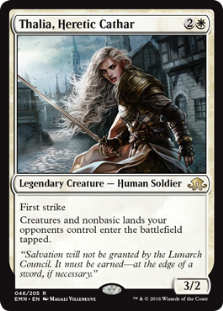
[/tippy], first by clearly defining and systematizing the oft-cited Bolt Test, and then by applying it to Thalia. In doing so, we'll grade her on weaknesses and strengths according to the Bolt Test before making recommendations about how Thalia can overcome her deficits to hit Modern tournament tables.
[wp_ad_camp_1]
(Re)Defining the Bolt Test
We never want to evaluate cards in a vacuum. In last week's Emrakul article, we used Ulamog, the Ceaseless Hunger as the gold standard Emrakul would need to meet or exceed to see Modern play. We also did this in the context of Tier 1 RG Tron, because if there's anything we've learned from previous set releases, it's that new cards tend to require a slot in an existing Tier 1 or Tier 2 deck if they want a fair Modern shot. We're big on context here at Modern Nexus, and nowhere is this notion of contextual analysis more relevant than in card evaluation.
 Like Emrakul and Ulamog, Thalia 2.0 lends herself to easy comparison with the original Thalia, Guardian of Thraben. But unlike Emrakul and Ulamog, our newest Thalia has an even more pressing bar she has to surpass beyond Guardian's current record of success. You've heard it, you've talked about it, and you probably hate it as much as many Moderners do, but we all knew the metric I'm referring to after just taking one glance at Thalia's stats: Modern's (in)famous Bolt Test.
Like Emrakul and Ulamog, Thalia 2.0 lends herself to easy comparison with the original Thalia, Guardian of Thraben. But unlike Emrakul and Ulamog, our newest Thalia has an even more pressing bar she has to surpass beyond Guardian's current record of success. You've heard it, you've talked about it, and you probably hate it as much as many Moderners do, but we all knew the metric I'm referring to after just taking one glance at Thalia's stats: Modern's (in)famous Bolt Test.
Love it or loathe it, the Bolt Test is where we need to start before we make any projections about Thalia's Modern odds. Indeed, any time you have a creature that does die to a single Lightning Bolt, you do need to take the Test into consideration. Bolt is the format's premier removal spell, seeing more play than any other removal option and generally appearing in more decks than any non-land card. It doesn't quite meet Force of Will/Brainstorm usage in Legacy, but with around 40% of decks using the instant, it's clearly a Modern mainstay.
But even knowing Bolt's prevalence still begs the question: what specific Test parameters should you use?
When most Modern players talk the Bolt Test, whether on Reddit, a forum like MTGSalvation, around your local game store tables, or in dismissive Tweets to dejected card designers, they're defining it in narrow terms. "Narrow" in the sense of an argumentative crawlspace where only one definition is allowed through at a time:
The Bolt Test (popular definition)
1. "Does the creature die to Lightning Bolt?"
2. "If yes, the creature is unplayable in Modern."
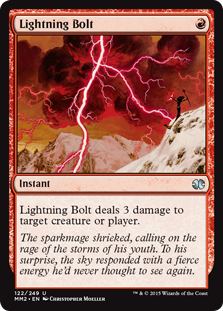 Better Wikipedia logicians than I can point to the logical and argumentative fallacies in this kind of definition, but I'll just let the results speak for themselves. The popular Bolt Test definition does not withstand even the slightest scrutiny. In aggressive decks, Goblin Guide, Wild Nacatl, and Steel Overseer (to name a few) die to Bolt and still see widespread Tier 1 and/or Tier 2 play. In slower midrange strategies, you still see Dark Confidant get maindeck honors, with plenty of lightning-rod dorks like Birds of Paradise accompanying more toolbox-oriented builds. Infect uses Blighted Agent. Death and Taxes use Thalia, Guardian of Thraben. In all those cases, we see frequent top-tier appearances by creatures that clearly die to Bolt. This means either the Bolt Test isn't real, or that we've misdefined it from the beginning.
Better Wikipedia logicians than I can point to the logical and argumentative fallacies in this kind of definition, but I'll just let the results speak for themselves. The popular Bolt Test definition does not withstand even the slightest scrutiny. In aggressive decks, Goblin Guide, Wild Nacatl, and Steel Overseer (to name a few) die to Bolt and still see widespread Tier 1 and/or Tier 2 play. In slower midrange strategies, you still see Dark Confidant get maindeck honors, with plenty of lightning-rod dorks like Birds of Paradise accompanying more toolbox-oriented builds. Infect uses Blighted Agent. Death and Taxes use Thalia, Guardian of Thraben. In all those cases, we see frequent top-tier appearances by creatures that clearly die to Bolt. This means either the Bolt Test isn't real, or that we've misdefined it from the beginning.
Back in May, our own Jordan Boisvert wrote an excellent article detailing creature playability benchmarks in Modern. He's also explicitly tackled the Bolt Test before in pushing the limits of playable creatures. You could read between the lines in both articles to come up with an early Bolt Test framework, but I want to make it explicit for future use. Synthesizing different creature playability standards with the Top Decks tierings and creatures used throughout Modern, here's the Bolt Test we should be using whenever we raise our "It's unplayable" torches to the sky:
The Bolt Test (refined definition)
1. "Does the creature die to Lightning Bolt at parity? If not, what is the resource difference?"
2. "Does the creature have a game effect even if it immediately dies to Bolt? If so, how valuable and reliable is the effect?"
3. "Does the creature take over the game if it is not Bolted? If so, how quick, consistent, and decisive is that impact?"
4. "If yes to any of the above, the creature might be playable in Modern."
Now we're talking. This revised Bolt Test is much better at both describing and even predicting what creatures might see play in Modern. It certainly produces favorable analyses of all the staples I mentioned above (Nacatl, Guide, Confidant, Agent, etc.), which is always a good place to start when testing definitional integrity.
Thinking through terms, here's a quick breakdown of concepts underlying each of the updated Test's qualifications, along with some creatures to illustrate the principles:
 Dying at parity and resources
Dying at parity and resources
Bolt costs one mana and one card. All creatures cost zero mana and up, and all cost at least one card. When assessing the trade between a Lightning Bolt and a creature, compare the Bolt resources (typically 1 and 1) with the creature resources.- Favorable: Wild Nacatl (parity), Thalia, Guardian of Thraben (parity)
- Unfavorable: Dark Confidant (two mana for one), Merrow Reejerey (three mana for one)
- Disaster: Kiki-Jiki, Mirror Breaker (five mana for one), Avatar of Discord (three mana for one, three cards for one)
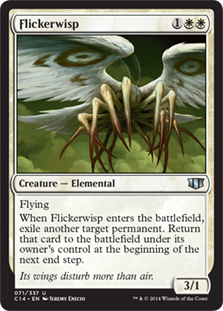 Impact even if bolted
Impact even if bolted
If a creature dies right away and still has a game effect, you've effective gained a resource or improved position even if the creature itself is no longer there. Impact should be valuable (i.e. relevant to the game-state and worth the investment), as well as reliable (i.e. you don't have to jump through hoops or setup to benefit).- Valuable and reliable: Flickerwisp (always produces an impactful and versatile exile effect which often either disrupts an opponent, saves your own cards, etc.).
- Neither valuable nor reliable: Knight of the White Orchid (doesn't always get a land and the acceleration isn't always valuable throughout the game).
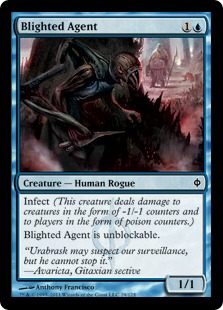
- Taking over a game
Sometimes, a creature runs away with a game if it doesn't die. If so, the marginal benefit of gambling on the creature is worth the marginal cost of risking its death to Bolt. That said, be honest and conservative in your estimation of a creature's ability to consistently and decisively dominate a game. - Consistent and decisive: Blighted Agent (can win in a single turn through blockers, requiring minimal support from a deck already packed with pump spells).
- Neither decisive nor consistent: Jori En, Ruin Diver (inconsistent card-draw effect that might not even draw you into relevant answers.
There's a good chance I'll go into greater depth on this in a future article. That might include both the spectrum of qualifications (for instance, creatures that have a decisive impact but maybe not a reliable one, like the blockable Glistener Elf) and potentially adding other criteria (such as Kitchen Finks or Etched Champion defending themselves from Bolt). I also want to sharpen the Test's grading scale---some creatures can pass just one of the three criteria and still be totally playable. See the ostensibly clunky Steel Overseer for a great example of that.
We'll revisit all these broader considerations when there aren't sweet Eldritch Moon spoilers orbiting around just waiting for evaluation. For now we're heading back to [tippy title="Thalia, Heretic Cathar" width="330" height="330"]
[/tippy], equipped with our new and improved Bolt Test guidelines.
Thalia Takes the Bolt Test
The first time we look at a creature, our immediate instinct should be to subject it to the more nuanced Bolt Test we discussed above. That means not evaluating the creature as a whole and in isolation, but assessing the card once for each of the Test's different parameters. Admittedly, there are times this analysis will produce the same result as if we applied the blunter "Dies to Bolt at all? Garbage" version we're accustomed to seeing online. You don't need all three criteria to know Thalia's best buddy Odric, Lunarch Marshal ain't making the Gatewatch junior varsity squad. For more borderline cases like Thalia herself, however, it's an invaluable tool, which is why we'll grade her on all the Test items.
Dying at parity
"Does Thalia die to Lightning Bolt at parity? If not, what is the resource difference?"
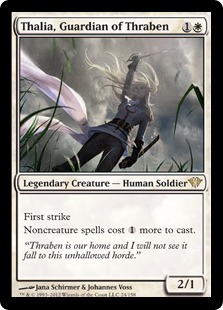 New Thalia gets off to a bad start by being at the topmost mana-cost end of creatures that do die to Bolt. It turns out spending your third turn to exclusively drop Thalia isn't very good if your opponent spent their third turn casting Tarmogoyf and holding up Bolt mana. Or just dropping Lava Spike on the draw with Bolt waiting in the wings. That two-mana resource difference can decide a game on the spot if you're behind or even on cards, and if you're already ahead then Thalia's ability is as win-more as it often gets.
New Thalia gets off to a bad start by being at the topmost mana-cost end of creatures that do die to Bolt. It turns out spending your third turn to exclusively drop Thalia isn't very good if your opponent spent their third turn casting Tarmogoyf and holding up Bolt mana. Or just dropping Lava Spike on the draw with Bolt waiting in the wings. That two-mana resource difference can decide a game on the spot if you're behind or even on cards, and if you're already ahead then Thalia's ability is as win-more as it often gets.
As a quick note, Thalia, Guardian of Thraben would earn an A here despite costing two mana. By making Bolt cost two itself, old Thalia effectively closes the resource gap other two-drops suffer from.
Grade: C
Again, I'll probably refine this in a later article, but I'm guessing a zero-mana resource difference is an A, one is a B, two is a C, and so on. Additional cards gained (Eternal Witness) or lost (Drekavac) would move you up or down half/whole letter grades. At three-mana with no added loss or gain, Thalia is a flat C.
Immediate game impact
"Does Thalia have a game effect even if she immediately dies to Bolt? If so, how valuable and reliable is her effect?"
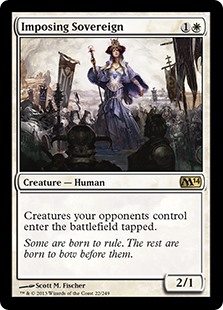 Eldritch Moon's spikey legend takes another hit off her game impact, which is neither particularly valuable nor reliable if she immediately eats the removal spell. In terms of value, if Thalia dies to Bolt, it will typically be before an opponent has cast a creature or played a land. Two notable exceptions to this include Thalia off Chord of Calling or Aether Vial (or any other instant-speed deployment mechanism), where you might catch a fetchland off-guard before Thalia gets zapped. Same goes for temporarily removing a new creature from the blocker list. That said, unless you're shutting down a creature with haste (bonus flavor points for Reality Smasher or, in Legacy, a hasty Emrakul), there's nothing too valuable about tapping down a potential blocker. Imposing Sovereign wasn't really shredding Modern until Thalia came along.
Eldritch Moon's spikey legend takes another hit off her game impact, which is neither particularly valuable nor reliable if she immediately eats the removal spell. In terms of value, if Thalia dies to Bolt, it will typically be before an opponent has cast a creature or played a land. Two notable exceptions to this include Thalia off Chord of Calling or Aether Vial (or any other instant-speed deployment mechanism), where you might catch a fetchland off-guard before Thalia gets zapped. Same goes for temporarily removing a new creature from the blocker list. That said, unless you're shutting down a creature with haste (bonus flavor points for Reality Smasher or, in Legacy, a hasty Emrakul), there's nothing too valuable about tapping down a potential blocker. Imposing Sovereign wasn't really shredding Modern until Thalia came along.
For Thalia to actually perform in any of those scenarios you need considerable setup: a Chord in hand and mana/creatures to use it; a Vial on three; a lucky Collected Company flip. This setup also needs to happen before you cast her, so losing Thalia in such a way ends up costing (and losing) additional resources if she dies immediately.
Grade: C-
Thalia is at least capable of having an immediate impact, even if it's less reliable, requires setup, and isn't not particularly strong. We'd reserve a D for something which had an impact that was flat out useless (Merfolk Spy), and an F for cards that literally had no impact if they die. Of course, plenty of cards with an F here see play (hi, most creatures in Affinity and Burn), so Thalia's C- is hardly game over.
Taking over the game
"Does Thalia take over the game if she is not bolted? If so, how quick, consistent, and decisive is her impact?"
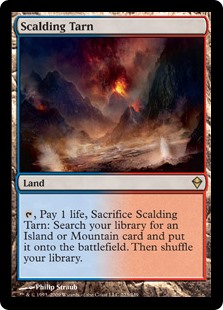 You didn't think we'd get much more than 2,000 words into the article without at least a few Thalia praises? Although the Cathar drops the ball in the first two Bolt Test qualifications, she earns much higher marks in her ability to out-tempo and dominate opponents. An early Thalia is devastating at slowing board development, forcing opponents to either sacrifice tempo to kill her off-curve, or to get mired in her taxation effect. Keyword in that sentence: early. The quicker Thalia hits play, the more powerful her effect becomes. This is in contrast to the older Thalia, which gummed up opposing plans at all phases of the game, even if her taxing was certainly better in early turns. New Thalia can't do much to tax a well-developed board, but if played before lands start dropping, she's downright oppressive. Fetchlands become absolutely unusable with Thalia out, and with many of Modern's grindier strategies relying on a fetch/shock manabase, Thalia is well-positioned to wreak havoc.
You didn't think we'd get much more than 2,000 words into the article without at least a few Thalia praises? Although the Cathar drops the ball in the first two Bolt Test qualifications, she earns much higher marks in her ability to out-tempo and dominate opponents. An early Thalia is devastating at slowing board development, forcing opponents to either sacrifice tempo to kill her off-curve, or to get mired in her taxation effect. Keyword in that sentence: early. The quicker Thalia hits play, the more powerful her effect becomes. This is in contrast to the older Thalia, which gummed up opposing plans at all phases of the game, even if her taxing was certainly better in early turns. New Thalia can't do much to tax a well-developed board, but if played before lands start dropping, she's downright oppressive. Fetchlands become absolutely unusable with Thalia out, and with many of Modern's grindier strategies relying on a fetch/shock manabase, Thalia is well-positioned to wreak havoc.
As a preview to the final section, these demands situate Thalia as a great addition to decks using mana dorks. Noble Hierarch and Birds of Paradise play very well with Thalia, and if curved into on the play, she only gives your opponent one turn (depending on their mana usage) to respond before their Hallowed Fountains become Coastal Towers and fetchlands become even worse, if that's possible, Terramorphic Expanses. These strategies can also capitalize on Thalia's creature-tapping to get a clock going, punching past tapped Tarmogoyfs to pull a game out of reach.
Grade: B+ (A- if on turn two)
In matchups where Thalia is good, she's very good, or downright great if cast early. What does a deck like Abzan Company do if it's on the draw against Thalia with no opening dork? Thalia even screws with Chord convokes, on top of the chaos she brings to Abzan's manabase. That's just one example, but Modern has a number of others where she causes major problems. I'd definitely hate to see her on turn two if I'm trying to assemble my turn 3-4 Tron on MTGO!
Final Thalia, Heretic Cathar's grade: B (B+ on turn two)
If a creature can pass any of the Bolt Test's qualifications, we're going to frequently weigh that pass more than we do the failures. Modern also rewards swingy, high-impact plays, so [tippy title="Thalia, Heretic Cathar" width="330" height="330"]
[/tippy] passing the "game takeover" criterion is a promising start. Naturally, timing really matters for Thalia. An organic turn three Thalia on the play will be decent in some matchups and irrelevant in others. Turn five Thalia is as bad as it sounds. Turn two Thalia, however, is an utter nightmare for a lot of decks, although the three-mana casting cost still prevents her from really reaching A- or higher. Modern is a high-power format and plenty of B cards don't make it, but a B+ contender with the right top-tier home has much better odds.
Bringing Thalia, Heretic Cathar to Modern
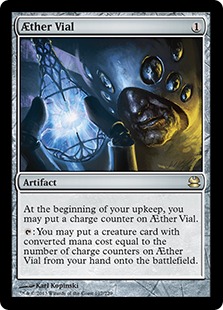 I've become more generous towards Thalia in the past few days, and that's largely because I've stopped thinking about her as a Death and Taxes roleplayer and started thinking about her dork synergy. Aether Vial has never been a bigger trap in Modern. Although Thalia's name is virtually synonymous with "Death and Taxes," her newest iteration is just plain bad with the Vial. At earliest, Modern D&T will land a Thalia on turn three with no potential for the turn two lockdown. At latest, you topdeck Thalia in the mid-game where she has no impact other than to provide an efficient blocker for Nacatls and stymie blockers. Along the way, Vial does not accelerate her into play until turn four at earliest. No thank you. Sure, Flickerwisp/Eldrazi Displacer and Thalia is kind of cute, but Thalia isn't in the cute business. She's a Game of Thrones-style woman of action.
I've become more generous towards Thalia in the past few days, and that's largely because I've stopped thinking about her as a Death and Taxes roleplayer and started thinking about her dork synergy. Aether Vial has never been a bigger trap in Modern. Although Thalia's name is virtually synonymous with "Death and Taxes," her newest iteration is just plain bad with the Vial. At earliest, Modern D&T will land a Thalia on turn three with no potential for the turn two lockdown. At latest, you topdeck Thalia in the mid-game where she has no impact other than to provide an efficient blocker for Nacatls and stymie blockers. Along the way, Vial does not accelerate her into play until turn four at earliest. No thank you. Sure, Flickerwisp/Eldrazi Displacer and Thalia is kind of cute, but Thalia isn't in the cute business. She's a Game of Thrones-style woman of action.
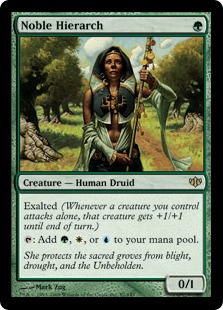 Of course, that moves us right back to mana dorks and the decks that use them. If you're using Noble Hierarch, Birds of Paradise and/or any other one-drop mana guy, you will want to try out [tippy title="Thalia, Heretic Cathar" width="330" height="330"]
Of course, that moves us right back to mana dorks and the decks that use them. If you're using Noble Hierarch, Birds of Paradise and/or any other one-drop mana guy, you will want to try out [tippy title="Thalia, Heretic Cathar" width="330" height="330"]
[/tippy] as a solid turn two drop. I'm looking straight at the Kiki Chord, Bant Eldrazi, and Abzan Company players in the top-tiers, as well as the Abzan Liege and GW Hatebears pilots hoping to bring their decks back. I've done some preliminary and decidedly unscientific tests with Thalia to see how these lines play out, and I've definitely seen merits to this opening against all the fetchland-heavy strategies. Tron also hates seeing Thalia in the opener. Turn two Thalia on the play against the Urza's lands can easily slow an opponent's natural Urzatron development by 1-2 turns, buying Abzan Company the time it needs to find an answer or win on its own via Murderous Redcap. Time will tell if that's a valuable synergy or still just a cute game impact, but I'm more optimistic today than when I first saw Thalia and only thought about Vials. Also, Thalia 1.0 and Thalia 2.0 really put the screws to an opponent if they're both in play.
Thanks for reading and for joining me on this dual Eldritch Moon evaluation and Bolt Test breakdown. We still haven't seen any real Modern knockouts in the new set, but previews are young and hopes are still high. Sorcery-speed Accumulated Knowledge isn't exactly a step in the right direction, but emerge has all the trappings of a new busted Modern cost-reduction mechanic. See you all next week as we take on more Moon spoilers and let me know in the comments if you have any Eldritch experiences or test results of your own to report.




Interesting breakdown of the Bolt Test. I’ll be curious to apply it to Lone Rider, which is a new card that will definitely be hitting the kitchen table, but I’ve been trying to decide if it could be non-shameful to bring to my FLGS’s Modern night.
Rider is like a more conditional Ajani’s Pridemate. Maybe 1-2 could fit in the deck as Pridemate’s 5-6, but I’m not optimistic. It’s better in the RW deck versions where you can T2 Rider and T3 Helix with one mana up for something else. My big problem with Rider is that its unflipped side is very low-impact at 1/1. Pridemate typically lands as a 3/3 or bigger with a Sister in play, so he can tangle with Guide, Nacatl, and other Burn/Zoo creatures.
I disagree with your comparison, as Pridemate never gains trample, first strike, or lifelink. Pridemate can grow to the moon but get chumped by tokens or mana dorks all day long. Rider stops at 4, but presents a more significant threat (not to mention being able to flip later copies of itself). I know it’s easy to stop after the commonality of “2-drop that grows from lifegain”, but ignoring three very relevant keywords is a mistake. On top of that, Pridemate needs to hit the table before the lifegain happens, while Rider can be put down after you know he’ll flip; and Pridemate wants multiple triggers while Rider only needs one.
Now, I’m not saying I’m convinced it’s Modern material, but it’s too different from Pridemate for that to be a valid comparison.
I’d be curious to hear what David (or anyone on the MN team) has to say about Unsubstantiate in modern fish. It looks like a great replacement for vapor snags or echoing truth, as it can stall out a supreme verdict or an abrupt decay. Fish slots come at a premium, and any that can serve as a pseudo counter and a removal spell seems decent to me.
I am currently forming my opinion about that card and some others. Will be doing a preview article next week in all likelihood.
Oh yeah, Unsubstantiate is another one I’m curious about as well. Seems at least worth looking into.
Green white hatebars probably like her. A lot of their creatures fails the bolt test already.
They do, although I will say they mostly fail only the “regular” Bolt Test and not the expanded one I defined here. Even if those creatures die to Bolt, they have huge impact on the game and/or create value regardless of whether or not they die.
I’m on board with the “try to get her out there by T2” idea. I don’t think she’s awfully impactful if cast by T3 or Vialed in by T4, so GW Hatebears it is.
Yeah, that’s where I am too. Vial on T4 is really horrible, and a natural T3 cast isn’t great either.
I don’t think anyone has ever thought the bolt test was literally “dies to bolt unplayable” as pretty much every competitive deck in the format runs something that dies to bolt – so that’s a pretty lame straw man. That being said I agree with your definition of resource parity, immediate impact, and ability to take over a game.
Note Thalia affects nonbasics only. It’s still annoying with fetches, but when mana is needed most will be able to get a basic.
Personally doubt she’s playable – if it had been 2 cmc for a 2/1 with this effect then yep but as is – not likely
You’d be surprised—I’ve heard and seen plenty of people describe the Bolt Test that way. I agree with you that Thalia seems very conditional and therefore pretty bad.
That argument is rampant online. I see it literally every time a creature with < 4 toughness gets previewed and multiple people evaluate the card as "bad; dies to Bolt." I wish it was just a lame straw man, but it's actually the argument people make. I also hear it ALL the time in-person. If she's playable, it's because you can drop her T2 on a dork. If that's not good enough, then I agree she' snot going to make the cut.
It’s really not a bad pick for D&T, though I agree it shines in the WG lists.
It’s essentially a better Blade Splicer, which still sees play in many lists. It also is likely to do more lifting than Aven Mindcensor.
No mention of Eiganjo Castle anywhere? I understand this discussion usually relates to the turn the card in question is played, but it’s worth mentioning there is a card that protects her. Do I want to keep 5 mana up to cast her and protect her though? No thanks.